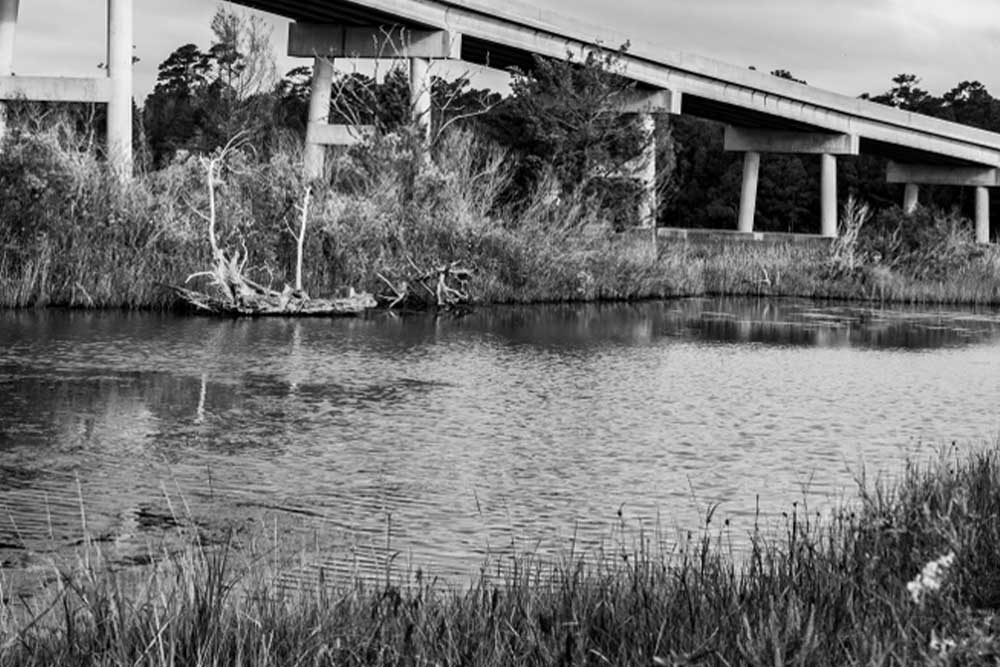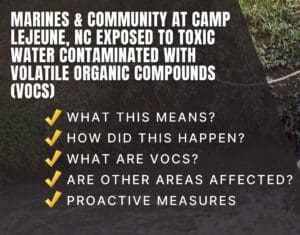In the early 1940s, the U.S. government approved construction of the Camp Lejeune Marine Corps base in Jacksonville, North Carolina. For years, it housed soldiers training for duty, as well as their families. Nearby water sources provided all the water inhabitants needed for drinking, bathing, cooking, and cleaning. Unfortunately, over time, the water supply became a significant source of exposure to deadly toxins.
The most harmful chemicals found in the water supply were identified primarily as tetrachloroethylene, also known as perchloroethylene (PCE), trichloroethylene (TCE), benzene and vinyl chloride.
The main source for PCE was an off-base dry cleaning company called ABC One-Hour Cleaners owned by Victor and Martha Melts, who settled with the Environmental Protection Agency (EPA) in 2000 for $270,000. For at least 30 years, the dry cleaning company dumped tons of dry cleaning solvents into the ground that leaked into a nearby water well supplying water at Camp Lejeune.
Another source of contaminants was from on base where solvents and degreasers were used to clean weaponry and degrease and clean military equipment. These solvents and degreasers leaked into another well that supplied water to those stationed at Camp Lejeune.
It is estimated that between 750,000 and a million military personnel and their family members, as well as civilian workers, were exposed to these harmful chemicals over this time period by drinking the water, eating food prepared with contaminated water, bathing in the water, cleaning with the water or inhaling the contaminants.
The chemicals discovered by the EPA to have contaminated the water in these two water supplies have been identified as being carcinogenic (cancer-causing) chemicals as well as causing other diseases, illnesses and health conditions. Thanks to decades worth of study and research by the Agency for Toxic Substances and Disease Registry (ATSDR), there is a long list of cancers, diseases, illnesses and health conditions directly related to exposure to the chemicals found in the contaminated water at Camp Lejeune.
Cancers and Diseases Related to the Contaminated Water at Camp Lejeune
Ther number of different cancers and diseases related to the chemicals found in the contaminated Camp Lejeune waters today is staggering.
Studies and research have shown that exposure to PCE causes cancers of the liver, kidney, and blood system, and may lead to a higher risk of getting bladder cancer, multiple myeloma, or non-Hodgkin’s lymphoma. Evidence is compelling that TCE can cause kidney cancer in people and some evidence for trichloroethylene-induced liver cancer and malignant lymphoma. Tests with animal subjects show that prolonged exposure to TCE results in increased liver cancer and increased kidney cancer and testicular cancer. Prolonged exposure to benzene has been linked to leukemia. There is sufficient evidence to show that exposure to vinyl chloride causes liver cancer.
When claims first started being fulfilled by the Department of Veterans Affairs (VA), it was based off of a short list of presumptive conditions:
- Adult leukemia
- Aplastic anemia and other myelodysplastic syndromes
- Bladder cancer
- Kidney cancer
- Liver cancer
- Multiple myeloma
- Non-Hodgkin’s lymphoma
- Parkinson’s disease
In 2012, in accordance with the Camp Lejeune health care law, also referred to as the Camp Lejeune Families Act of 2012, this list of presumptive conditions was expanded to include:
- Esophageal cancer
- Breast cancer
- Kidney cancer
- Multiple myeloma
- Renal toxicity
- Female infertility
- Scleroderma
- Non-Hodgkin’s lymphoma
- Lung cancer
- Bladder cancer
- Leukemia
- Myelodysplastic syndromes
- Hepatic steatosis
- Miscarriage
- Neurobehavioral effects
Under the Camp Lejeune Justice Act of 2022 (CLJA), the list of cancers, diseases and other illnesses and injuries has been expanded to include 23 additional maladies:
- Aplastic anemia
- Babies being small for gestational age
- Bladder cancer
- Brain cancer
- Breast cancer
- Cardiac defects
- Cervical cancer
- End-stage renal disease
- Esophageal cancer
- Eye defects
- Fetal death
- Hepatic steatosis
- Hodgkin lymphoma
- Impaired immune system function
- Infertility
- Kidney cancer
- Leukemia
- Liver cancer
- Liver cirrhosis
- Low birth weight
- Lung cancer
- Major malformations
- Miscarriage
- Mood effects (anxiety or depression)
- Multiple myeloma
- Nasal passages blocked with bone tissue
- Neural tube defects
- Neurobehavioral effects (performance deficits such as delayed recall or ALS)
- Neurological effects (memory loss, attention or color blindness)
- Non-Hodgkin lymphoma
- Oral cleft defects
- Ovarian cancer
- Parkinson’s disease
- Prostate cancer
- Rectal cancer
- Renal toxicity
- Scleroderma
- Skin disorders
- Soft tissue cancer
Fortunately, not everyone who was exposed to the dangerous chemical contamination of the water at Camp Lejeune developed any of the life-altering cancers, diseases, illnesses or detrimental health conditions listed above. Still, there are thousands, even ten or hundreds of thousands of victims, who have wrongfully died from these cancers and diseases, and others who have suffered and continue to suffer from these maladies.
Luckily, the monumental passage of the CLJA means word is spreading fast and broad that help is available to these victims in the form of health care treatment, benefits and compensation. Join the Many is proud to count ourselves among those advocates, standing by to educate potential victims on their legal rights and help them claim the compensation they deserve.
Symptoms to Watch For
If you or someone you love were exposed to the contaminated water at Camp Lejeune, and have not yet been diagnosed with a cancer or another condition, it is still recommended to screen for any signs of illness. The sooner you’re diagnosed, the sooner you can receive treatment. Here are some symptoms to watch out for in some of the more common ailments associated with exposure.
Bladder Cancer
Bladder cancer is a common type of cancer that usually forms in the cells lining the bladder, the tubes that carry urine from the kidneys to the bladder (known as the ureter), or the tubes that lead urine out of the body (urethra). Military personnel, their families, and civilian employees exposed to both PCE and TCE have an increased risk of developing bladder cancer. Symptoms of bladder cancer include back pain, difficult or painful urination, frequent urination, and very dark or bloody urine.
Breast Cancer
One of the most common types of cancers linked to Camp Lejeune water contamination is breast cancer. There are a number of symptoms that women should be aware of when it comes to breast cancer. These include a change in the size or shape of the breasts, a change in the texture of the skin on the breasts; dry, flaky, red, or thickened skin on the breast, nipple retraction or turning inward, pain in the breast or nipple, skin dimpling (resembling an orange peel in some cases), a lump in the breast, swelling (in all or part of the breast), even if no lump is felt, swollen lymph nodes near the collarbone or under the arm, and discharge from the nipple. If you experience any of these symptoms, it is important to see a doctor right away.
Cervical Cancer
Cervical cancer develops in the tissues of the cervix, the lower part of the uterus. Cervical cancer is caused by a virus known as human papillomavirus (HPV). Researchers believe that the contaminated water at Camp Lejeune may have increased the risk of cervical cancer by exposing women to HPV. There are a number of symptoms associated with cervical cancer. These include bleeding between periods, bleeding after sexual intercourse, and pain during sexual intercourse.
Esophageal Cancer
Esophageal cancer is relatively rare, accounting for only about 1% of all cancers diagnosed in the United States each year. However, it is one of the deadliest types of cancer, with a five-year survival rate of only about 20%. This is because esophageal cancer often goes undetected until it has spread to other parts of the body. Symptoms of esophageal cancer include difficulty swallowing, weight loss, and pain in the throat or back. Contaminated water at Camp Lejeune may have increased the risk of esophageal cancer by damaging the DNA of the cells in the esophagus.
Kidney Cancer
Kidney cancer begins in the cells of the kidney and can spread to other parts of the body. The contaminated water has been linked to an increased risk of kidney cancer due to exposure to chemicals like benzene and trichloroethylene (TCE). The risk is highest among people who were exposed to the water for longer periods of time. Symptoms of kidney cancer include blood in the urine, a lump and/or pain in the side or lower back, a mass in the abdomen, exhaustion or fatigue, loss of appetite, anemia (low red blood count), persistent fever, and unintended weight loss. If you experience any of these symptoms, it is important to see a doctor right away.
Liver Cancer
The ATSDR found that men who were exposed to the contaminated water at Camp Lejeune were twice as likely to develop liver cancer as those who had not been exposed. It is believed that the contaminated water may have increased the risk of liver cancer by exposing people to chemicals like benzene and trichloroethylene (TCE). These chemicals can damage DNA and lead to the development of cancer. There are a number of symptoms associated with liver cancer. These include abdominal swelling, fatigue, loss of appetite, muscle weakness, nausea and vomiting, pain in the upper abdomen, unintended weight loss, white, chalky bowel movements, and yellow discoloration of the eyes and skin (jaundice).
Non-Hodgkin’s Lymphoma
The risk of developing non-Hodgkin’s lymphoma was found to be two times greater for those who drank the contaminated water at Camp Lejeune. This is cancer that begins in the cells of the lymph system, part of the immune system. The symptoms of non-Hodgkin’s lymphoma can include abdominal pain or swelling, chest pain, coughing, swollen lymph nodes in the armpits, groin, or neck, fatigue, fever, night sweats, trouble breathing and unintended weight loss. Contaminated water at Camp Lejeune has the elements to create a toxic environment in the body and suppress the immune system. It is important to see a doctor if you experience any of these symptoms. Early detection is important for the successful treatment of this type of cancer.
Lung Cancer
Lung cancer is one of the deadliest types of cancer and can be difficult to catch in its early stages. The risk of lung cancer increases with exposure to certain chemicals, including benzene. The most common symptom of lung cancer is a cough that does not go away. Other symptoms include chest pain, shortness of breath, wheezing, and loss of appetite. These symptoms can also be caused by other conditions, so it is important to see your doctor if you are experiencing any of them. Lung cancer is treated with surgery, chemotherapy, and radiation therapy. The type of treatment depends on the stage of cancer and the individual patient.
Prostate Cancer
Prostate cancer is one of the most common types of cancer. In its early stages, prostate cancer may not cause any noticeable symptoms. Symptoms of advanced prostate cancer include blood in the semen and/or urine, bone pain, erectile dysfunction, less forceful urine stream, trouble urinating, unintended weight loss.
Multiple Myeloma
The occurrence of this cancer is increased by 56% for those exposed to the Camp Lejeune water contamination. This cancer attacks plasma cells in the bone marrow and causes problems with the production of blood cells. Multiple myeloma is hard to diagnose in its early stages because it shares symptoms with other illnesses. These can include fatigue, bone pain or fractures, especially in the chest or spine, frequent infections, nausea, anemia, confusion, constipation, excessive thirst, loss of appetite, numbness or weakness in the legs and unintended weight loss. The exact cause of multiple myeloma is unknown, but it is thought to be caused by a combination of environmental and genetic factors.
Infertility In Women
An increased risk of infertility in women has also been linked to Camp Lejeune’s contaminated water. Infertility is defined as the inability to conceive after one year of unprotected sex. There are many factors that can contribute to infertility, and it is often a complex condition with no clear cause. However, exposure to certain chemicals has been linked to an increased risk of infertility in women, and it is thought that the Camp Lejeune water contamination may have played a role. If you believe you were exposed to contaminated water at Camp Lejeune, it is critical that you speak with your doctor about your fertility options.
Adult Leukemia
Adult leukemia is the abnormal growth of blood cells in the bone marrow. This abnormal growth of blood cells can crowd out healthy blood cells and lead to serious health problems. People who were exposed to the contaminated water at Camp Lejeune were found to be more likely to develop adult leukemia. The symptoms of adult leukemia can include bleeding gums, bone or joint pain, fatigue, fever or night sweats, frequent infections, nosebleeds, pale skin, purplish or darkened patches of skin, rash or tiny red spots on the skin (petechiae), shortness of breath, swollen lymph nodes in the groin, neck, stomach, or underarm areas, unexplained weight loss, and easy bruising or bleeding. Most people with adult leukemia will need treatment with chemotherapy or radiation. The water at Camp Lejeune was contaminated with benzene, a known carcinogen that has been linked to leukemia. If you were exposed to contaminated water, it is important to talk to your doctor about your risk for leukemia.
Aplastic Anemia
The chemicals in the water at Camp Lejeune have been linked to aplastic anemia, which is a condition in which the body does not produce enough new blood cells. Risk factors that have been linked to aplastic anemia include exposure to chemicals like benzene and trichloroethylene (TCE). Symptoms of aplastic anemia can include fatigue, shortness of breath, and easy bruising or bleeding. The treatment for aplastic anemia is a bone marrow transplant. The symptoms can be mild or severe, and they can come on suddenly or gradually. In a research study of people who were exposed to the contaminated water at Camp Lejeune, the risk for aplastic anemia was found to be increased.
Renal Toxicity
Another symptom that is common in individuals who have been exposed to contaminated water at Camp Lejeune is renal toxicity. Renal toxicity is damage to the kidneys that can lead to kidney failure. Some of the symptoms associated with renal toxicity include changes in urination, frequent urination, blood in the urine, swelling in the feet, ankles, or legs, nausea and weakness. This condition can be very serious and if you believe that you may have been exposed to contaminated water at Camp Lejeune, it is important to seek medical attention as soon as possible.
Scleroderma
Scleroderma (or systemic sclerosis) is a potentially fatal autoimmune disease that involves the hardening, inflammation, or thickening of the skin. It can also affect the tissues and organs inside the body, including the lungs, heart, and kidneys. The symptoms of scleroderma vary depending on the organs affected. Skin symptoms may include hard, thickening, or tight skin, dry, itchy skin, burning or swelling, less sweating, muscle weakness, salt-and-pepper-like patches of skin on the back, chest, or scalp, skin color changes, hair loss, sores or ulcers on fingertips, visible blood vessels, stiff joints, difficulty moving, and reduced blood flow to the extremities. When scleroderma affects the internal organs, it can cause shortness of breath, heartburn, swelling in the arms and legs, fatigue, and numbness or tingling in the fingers and toes. There is no cure for scleroderma, but treatments are available to help manage the symptoms. Although the precise cause of scleroderma is still unknown, it is thought to be linked to an overactive immune system and contaminated water.
Hepatic Steatosis
One of the most common symptoms associated with Camp Lejeune water contamination is hepatic steatosis, more commonly known as fatty liver disease. This condition occurs when there is an accumulation of fat in the liver cells. Symptoms of hepatic steatosis can include fatigue, weight loss, and pain in the upper right abdomen. In some cases, fatty liver disease can lead to more serious conditions, such as cirrhosis of the liver or liver cancer. The treatment for hepatic steatosis generally involves lifestyle changes, such as diet and exercise. In some cases, medication may be necessary to control the symptoms.
Neurobehavioral Effects
Neurobehavioral effects refer to how changes to the nervous system, particularly the brain, can affect our emotion, behavior, and learning. Consuming the toxic water at Camp Lejeune could have negatively impacted someone’s nervous system and caused many different changes to their physical abilities and mental state as a result. Neurobehavioral effects may include aggression, anxiety, attention difficulties or trouble concentrating, confusion, dementia, depression, difficulty sleeping or insomnia, dizziness, fatigue, headaches, lack of coordination, learning disorders, memory issues, poor motor skills, post-traumatic stress disorder (PTSD), tension, tremors or involuntary movements and weakness. Neurobehavioral effects have been reported in children exposed to volatile organic chemicals (VOCs) in drinking water. These effects include problems with attention, learning, and social interactions as well as aggressive behavior. Contaminated water at Camp Lejeune was also linked to an increased risk of Parkinson’s disease, amyotrophic lateral sclerosis (ALS), and other neurological diseases. Researchers are still working to understand all of the potential health effects of exposure to VOCs. These neurobehavioral effects are of particular concern because they can last a lifetime.
What to Do Next
This is a lot to take in. The bottom line is, if your previous or current health condition resonated with any of the descriptions or symptoms above, see your primary care physician right away and get tested for any of the cancers or illnesses just mentioned. The Camp Lejeune Justice Act provides for you to make a claim and get the health care treatment, benefits and compensation you deserve without hindrance.




